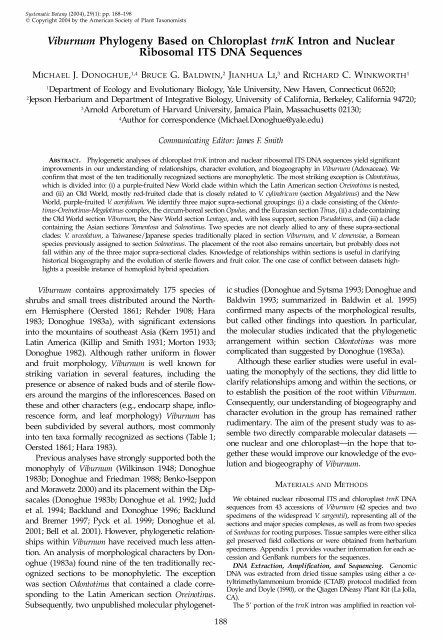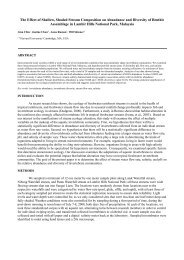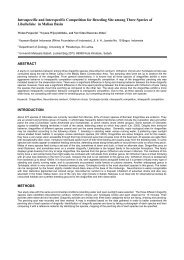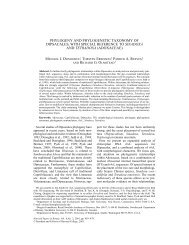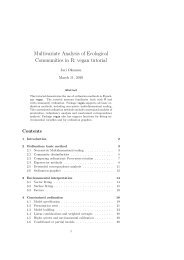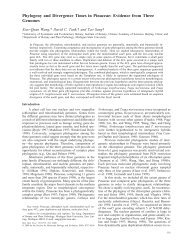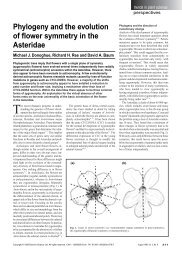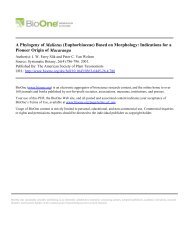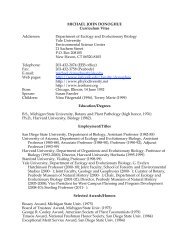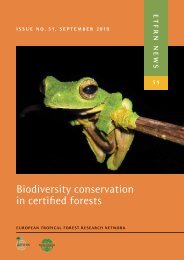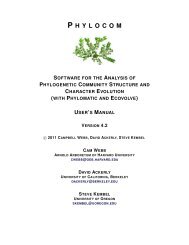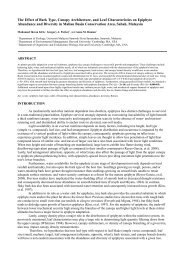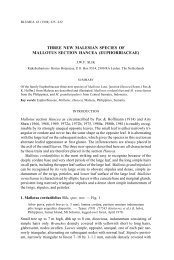Viburnum Phylogeny Based on Chloroplast trnK Intron and Nuclear ...
Viburnum Phylogeny Based on Chloroplast trnK Intron and Nuclear ...
Viburnum Phylogeny Based on Chloroplast trnK Intron and Nuclear ...
Create successful ePaper yourself
Turn your PDF publications into a flip-book with our unique Google optimized e-Paper software.
Systematic Botany (2004), 29(1): pp. 188–198<br />
q Copyright 2004 by the American Society of Plant Tax<strong>on</strong>omists<br />
<str<strong>on</strong>g>Viburnum</str<strong>on</strong>g> <str<strong>on</strong>g>Phylogeny</str<strong>on</strong>g> <str<strong>on</strong>g>Based</str<strong>on</strong>g> <strong>on</strong> <strong>Chloroplast</strong> <strong>trnK</strong> Intr<strong>on</strong> <strong>and</strong> <strong>Nuclear</strong><br />
Ribosomal ITS DNA Sequences<br />
MICHAEL J. DONOGHUE, 1,4 BRUCE G. BALDWIN, 2 JIANHUA LI, 3 <strong>and</strong> RICHARD C. WINKWORTH 1<br />
1 Department of Ecology <strong>and</strong> Evoluti<strong>on</strong>ary Biology, Yale University, New Haven, C<strong>on</strong>necticut 06520;<br />
2 Jeps<strong>on</strong> Herbarium <strong>and</strong> Department of Integrative Biology, University of California, Berkeley, California 94720;<br />
3 Arnold Arboretum of Harvard University, Jamaica Plain, Massachusetts 02130;<br />
4 Author for corresp<strong>on</strong>dence (Michael.D<strong>on</strong>oghue@yale.edu)<br />
Communicating Editor: James F. Smith<br />
ABSTRACT. Phylogenetic analyses of chloroplast <strong>trnK</strong> intr<strong>on</strong> <strong>and</strong> nuclear ribosomal ITS DNA sequences yield signicant<br />
improvements in our underst<strong>and</strong>ing of relati<strong>on</strong>ships, character evoluti<strong>on</strong>, <strong>and</strong> biogeography in <str<strong>on</strong>g>Viburnum</str<strong>on</strong>g> (Adoxaceae). We<br />
c<strong>on</strong>rm that most of the ten traditi<strong>on</strong>ally recognized secti<strong>on</strong>s are m<strong>on</strong>ophyletic. The most striking excepti<strong>on</strong> is Od<strong>on</strong>totinus,<br />
which is divided into: (i) a purple-fruited New World clade within which the Latin American secti<strong>on</strong> Oreinotinus is nested,<br />
<strong>and</strong> (ii) an Old World, mostly red-fruited clade that is closely related to V. cylindricum (secti<strong>on</strong> Megalotinus) <strong>and</strong> the New<br />
World, purple-fruited V. acerifolium. We identify three major supra-secti<strong>on</strong>al groupings: (i) a clade c<strong>on</strong>sisting of the Od<strong>on</strong>totinus-Oreinotinus-Megalotinus<br />
complex, the circum-boreal secti<strong>on</strong> Opulus, <strong>and</strong> the Eurasian secti<strong>on</strong> Tinus, (ii) a clade c<strong>on</strong>taining<br />
the Old World secti<strong>on</strong> <str<strong>on</strong>g>Viburnum</str<strong>on</strong>g>, the New World secti<strong>on</strong> Lentago, <strong>and</strong>, with less support, secti<strong>on</strong> Pseudotinus, <strong>and</strong> (iii) a clade<br />
c<strong>on</strong>taining the Asian secti<strong>on</strong>s Tomentosa <strong>and</strong> Solenotinus. Two species are not clearly allied to any of these supra-secti<strong>on</strong>al<br />
clades: V. urceolatum, a Taiwanese/Japanese species traditi<strong>on</strong>ally placed in secti<strong>on</strong> <str<strong>on</strong>g>Viburnum</str<strong>on</strong>g>, <strong>and</strong> V. clemensiae, a Bornean<br />
species previously assigned to secti<strong>on</strong> Solenotinus. The placement of the root also remains uncertain, but probably does not<br />
fall within any of the three major supra-secti<strong>on</strong>al clades. Knowledge of relati<strong>on</strong>ships within secti<strong>on</strong>s is useful in clarifying<br />
historical biogeography <strong>and</strong> the evoluti<strong>on</strong> of sterile owers <strong>and</strong> fruit color. The <strong>on</strong>e case of c<strong>on</strong>ict between datasets highlights<br />
a possible instance of homoploid hybrid speciati<strong>on</strong>.<br />
<str<strong>on</strong>g>Viburnum</str<strong>on</strong>g> c<strong>on</strong>tains approximately 175 species of<br />
shrubs <strong>and</strong> small trees distributed around the Northern<br />
Hemisphere (Oersted 1861; Rehder 1908; Hara<br />
1983; D<strong>on</strong>oghue 1983a), with signicant extensi<strong>on</strong>s<br />
into the mountains of southeast Asia (Kern 1951) <strong>and</strong><br />
Latin America (Killip <strong>and</strong> Smith 1931; Mort<strong>on</strong> 1933;<br />
D<strong>on</strong>oghue 1982). Although rather uniform in ower<br />
<strong>and</strong> fruit morphology, <str<strong>on</strong>g>Viburnum</str<strong>on</strong>g> is well known for<br />
striking variati<strong>on</strong> in several features, including the<br />
presence or absence of naked buds <strong>and</strong> of sterile owers<br />
around the margins of the inorescences. <str<strong>on</strong>g>Based</str<strong>on</strong>g> <strong>on</strong><br />
these <strong>and</strong> other characters (e.g., endocarp shape, inorescence<br />
form, <strong>and</strong> leaf morphology) <str<strong>on</strong>g>Viburnum</str<strong>on</strong>g> has<br />
been subdivided by several authors, most comm<strong>on</strong>ly<br />
into ten taxa formally recognized as secti<strong>on</strong>s (Table 1;<br />
Oersted 1861; Hara 1983).<br />
Previous analyses have str<strong>on</strong>gly supported both the<br />
m<strong>on</strong>ophyly of <str<strong>on</strong>g>Viburnum</str<strong>on</strong>g> (Wilkins<strong>on</strong> 1948; D<strong>on</strong>oghue<br />
1983b; D<strong>on</strong>oghue <strong>and</strong> Friedman 1988; Benko-Isepp<strong>on</strong><br />
<strong>and</strong> Morawetz 2000) <strong>and</strong> its placement within the Dipsacales<br />
(D<strong>on</strong>oghue 1983b; D<strong>on</strong>oghue et al. 1992; Judd<br />
et al. 1994; Backlund <strong>and</strong> D<strong>on</strong>oghue 1996; Backlund<br />
<strong>and</strong> Bremer 1997; Pyck et al. 1999; D<strong>on</strong>oghue et al.<br />
2001; Bell et al. 2001). However, phylogenetic relati<strong>on</strong>ships<br />
within <str<strong>on</strong>g>Viburnum</str<strong>on</strong>g> have received much less attenti<strong>on</strong>.<br />
An analysis of morphological characters by D<strong>on</strong>oghue<br />
(1983a) found nine of the ten traditi<strong>on</strong>ally recognized<br />
secti<strong>on</strong>s to be m<strong>on</strong>ophyletic. The excepti<strong>on</strong><br />
was secti<strong>on</strong> Od<strong>on</strong>totinus that c<strong>on</strong>tained a clade corresp<strong>on</strong>ding<br />
to the Latin American secti<strong>on</strong> Oreinotinus.<br />
Subsequently, two unpublished molecular phylogenet-<br />
188<br />
ic studies (D<strong>on</strong>oghue <strong>and</strong> Sytsma 1993; D<strong>on</strong>oghue <strong>and</strong><br />
Baldwin 1993; summarized in Baldwin et al. 1995)<br />
c<strong>on</strong>rmed many aspects of the morphological results,<br />
but called other ndings into questi<strong>on</strong>. In particular,<br />
the molecular studies indicated that the phylogenetic<br />
arrangement within secti<strong>on</strong> Od<strong>on</strong>totinus was more<br />
complicated than suggested by D<strong>on</strong>oghue (1983a).<br />
Although these earlier studies were useful in evaluating<br />
the m<strong>on</strong>ophyly of the secti<strong>on</strong>s, they did little to<br />
clarify relati<strong>on</strong>ships am<strong>on</strong>g <strong>and</strong> within the secti<strong>on</strong>s, or<br />
to establish the positi<strong>on</strong> of the root within <str<strong>on</strong>g>Viburnum</str<strong>on</strong>g>.<br />
C<strong>on</strong>sequently, our underst<strong>and</strong>ing of biogeography <strong>and</strong><br />
character evoluti<strong>on</strong> in the group has remained rather<br />
rudimentary. The aim of the present study was to assemble<br />
two directly comparable molecular datasets —<br />
<strong>on</strong>e nuclear <strong>and</strong> <strong>on</strong>e chloroplast—in the hope that together<br />
these would improve our knowledge of the evoluti<strong>on</strong><br />
<strong>and</strong> biogeography of <str<strong>on</strong>g>Viburnum</str<strong>on</strong>g>.<br />
MATERIALS AND METHODS<br />
We obtained nuclear ribosomal ITS <strong>and</strong> chloroplast <strong>trnK</strong> DNA<br />
sequences from 43 accessi<strong>on</strong>s of <str<strong>on</strong>g>Viburnum</str<strong>on</strong>g> (42 species <strong>and</strong> two<br />
specimens of the widespread V. sargentii), representing all of the<br />
secti<strong>on</strong>s <strong>and</strong> major species complexes, as well as from two species<br />
of Sambucus for rooting purposes. Tissue samples were either silica<br />
gel preserved eld collecti<strong>on</strong>s or were obtained from herbarium<br />
specimens. Appendix 1 provides voucher informati<strong>on</strong> for each accessi<strong>on</strong><br />
<strong>and</strong> GenBank numbers for the sequences.<br />
DNA Extracti<strong>on</strong>, Amplicati<strong>on</strong>, <strong>and</strong> Sequencing. Genomic<br />
DNA was extracted from dried tissue samples using either a cetyltrimethylamm<strong>on</strong>ium<br />
bromide (CTAB) protocol modied from<br />
Doyle <strong>and</strong> Doyle (1990), or the Qiagen DNeasy Plant Kit (La Jolla,<br />
CA).<br />
The 59 porti<strong>on</strong> of the <strong>trnK</strong> intr<strong>on</strong> was amplied in reacti<strong>on</strong> vol-
2004] DONOGHUE ET AL.: VIBURNUM PHYLOGENY<br />
189<br />
TABLE 1. Traditi<strong>on</strong>ally recognized secti<strong>on</strong>s of <str<strong>on</strong>g>Viburnum</str<strong>on</strong>g> (e.g.<br />
Hara 1983), with the approximate number of species <strong>and</strong> generalized<br />
geographic range for each.<br />
Secti<strong>on</strong> Lentago—7 spp. Eastern North America, except V. elatum<br />
in Mexico.<br />
Secti<strong>on</strong> Megalotinus—18 spp. Southeast Asia, extending west<br />
to India <strong>and</strong> south to Ind<strong>on</strong>esia.<br />
Secti<strong>on</strong> Od<strong>on</strong>totinus—45 spp. Temperate Asia <strong>and</strong> Eastern<br />
North America, except V. orientale in the Caucasus Mountains.<br />
Secti<strong>on</strong> Opulus—5 spp. Circumboreal.<br />
Secti<strong>on</strong> Oreinotinus—42 spp. Mexico, Caribbean, Central <strong>and</strong><br />
South America.<br />
Secti<strong>on</strong> Pseudotinus—4 spp. Asia, except V. lantanoides in<br />
Eastern North America.<br />
Secti<strong>on</strong> Solenotinus—25 spp. Asia, extending west to India<br />
<strong>and</strong> south to Ind<strong>on</strong>esia.<br />
Secti<strong>on</strong> Tinus—9 spp. Asia, except V. tinus in Europe.<br />
Secti<strong>on</strong> Tomentosa—2 spp. China, Japan.<br />
Secti<strong>on</strong> <str<strong>on</strong>g>Viburnum</str<strong>on</strong>g>—18 spp. Asia, except V. lantana in Europe.<br />
umes of 25 mL c<strong>on</strong>taining 13 PCR buffer (Perkin-Elmer), 6.25 mM<br />
MgCl 2 , 625 mM each dNTP (Invitrogen), 5% bovine serum albumin<br />
(v/v; New Engl<strong>and</strong> Biolabs), 10 pM each amplicati<strong>on</strong> primer,<br />
1 U AmpliTaq DNA polymerase (5 U/mL; Perkin-Elmer) <strong>and</strong><br />
10–100 ng of total cellular DNA. Typically the olig<strong>on</strong>ucleotide<br />
primers <strong>trnK</strong>-11 <strong>and</strong> matK510R (Young et al. 1999) were used in<br />
amplicati<strong>on</strong>s. However, when necessary these were combined<br />
with the internal primers VIBmatK1F (59-TATATTAGTGCCTGA-<br />
TACGGG-39) <strong>and</strong> VIBmatK1R (59-GATCTATCTAGCTCTAAA-<br />
TATC-39) to amplify the regi<strong>on</strong> in two overlapping secti<strong>on</strong>s. Thermocycling<br />
c<strong>on</strong>diti<strong>on</strong>s for PCR were: initial denaturati<strong>on</strong> at 988C<br />
for 3 minutes, 35 cycles of 1 minute at 958C (denature), 1 minute<br />
at 508C (annealing), <strong>and</strong> 2 minutes at 728C (extensi<strong>on</strong>), with a nal<br />
incubati<strong>on</strong> at 728C for 5 minutes. The ITS locus was amplied in<br />
20 mL reacti<strong>on</strong>s c<strong>on</strong>taining 13 Q soluti<strong>on</strong> (Qiagen), 13 PCR buffer<br />
(Qiagen), 500 mM each dNTP (Invitrogen), 10 pM primer ITS-I<br />
(Urbatsch et al. 2000), 10 pM primer ITS4 (White et al. 1990), 1 U<br />
DNA polymerase (5 U/mL; Qiagen), <strong>and</strong> 10–100 ng of total cellular<br />
DNA. The PCR prole was similar to that described for the<br />
<strong>trnK</strong> intr<strong>on</strong> but included a 548C annealing temperature <strong>and</strong> a 1<br />
minute extensi<strong>on</strong> time.<br />
Amplicati<strong>on</strong> products for both loci were puried using the<br />
QIAquick PCR Puricati<strong>on</strong> Kit (Qiagen). Automated sequencing of<br />
PCR fragments was performed using the ABI PRISM BigDye Terminator<br />
Cycle Sequencing Ready Reacti<strong>on</strong> kit <strong>and</strong> analyzed using<br />
either an ABI Prism 377 automated DNA sequencer or MJ Research<br />
BaseStati<strong>on</strong> 51. DNA sequencing of the <strong>trnK</strong> intr<strong>on</strong> used<br />
TABLE 2. Statistics from the aligned data matrices. For the ITS data set it is difcult to c<strong>on</strong>dently infer the exact number of indels<br />
due to uncertainty in the alignment of several regi<strong>on</strong>s.<br />
No. of taxa sequenced<br />
Sequence length (bp)<br />
Aligned length (bp)<br />
No. of indels<br />
No. of excluded sites<br />
No. of c<strong>on</strong>stant sites<br />
No. of varied sites<br />
No. of parsim<strong>on</strong>y informative sites<br />
%GC c<strong>on</strong>tent range (all sites)<br />
%GC c<strong>on</strong>tent mean (all sites)<br />
%GC c<strong>on</strong>tent range (varied sites <strong>on</strong>ly)<br />
%GC c<strong>on</strong>tent mean (varied sites <strong>on</strong>ly)<br />
the four olig<strong>on</strong>ucleotide primers described above; for the ITS locus<br />
the amplicati<strong>on</strong> primers <strong>and</strong>, when necessary, the primers ITS2<br />
<strong>and</strong> ITS3 (White et al. 1990) were used in sequencing.<br />
Initial results from the ITS locus suggested the presence of multiple<br />
sequence types in some accessi<strong>on</strong>s. In these cases PCR fragments<br />
were cl<strong>on</strong>ed using a TOPO TA Cl<strong>on</strong>ing Kit (Invitrogen).<br />
Between 10 <strong>and</strong> 15 col<strong>on</strong>ies from each cl<strong>on</strong>ing reacti<strong>on</strong> were<br />
screened by direct PCR. Screening used reacti<strong>on</strong> mixtures as described<br />
for the ITS locus <strong>and</strong> the M13 primers. Thermocycling<br />
c<strong>on</strong>diti<strong>on</strong>s were: cell lysis at 988C for 10 minutes, then 25 cycles<br />
of 1 minute at 958C, 1 minute at 558C, <strong>and</strong> 1 minute at 728C (extensi<strong>on</strong>),<br />
with a nal incubati<strong>on</strong> at 728C for 5 minutes. For each<br />
accessi<strong>on</strong> four or ve positive cl<strong>on</strong>es were puried using the QIAprep<br />
Spin Miniprep Kit (Qiagen) <strong>and</strong> sequenced as above using<br />
the M13 primers.<br />
Alignments <strong>and</strong> Phylogenetic Analyses. We obtained preliminary<br />
multiple alignments of DNA sequences using the progressive<br />
alignment procedure implemented in ClustalX (Thomps<strong>on</strong> et al.<br />
1994). These alignments were then visually inspected <strong>and</strong> adjusted<br />
for minor improvement. Prior to phylogenetic analyses all ambiguous<br />
<strong>and</strong> gapped positi<strong>on</strong>s were excluded from the data matrix.<br />
For the <strong>trnK</strong> intr<strong>on</strong> <strong>and</strong> ITS data sets phylogenetic trees were<br />
inferred using both maximum parsim<strong>on</strong>y (MP) <strong>and</strong> maximum<br />
likelihood (ML) optimality criteria as implemented in<br />
PAUP*4.0b10 (Swofford 2001). MP analyses used heuristic searches<br />
with ‘‘tree-bisecti<strong>on</strong>-rec<strong>on</strong>necti<strong>on</strong>’’ (TBR) branch swapping,<br />
zero-length branches collapsed, <strong>and</strong> all characters equally weighted.<br />
Analyses were repeated 100 times with RANDOMADDITION.<br />
To determine the best-tting model of sequence evoluti<strong>on</strong> for ML<br />
analyses, a hierarchical series of likelihood ratio tests was performed<br />
<strong>on</strong> the MP tree topologies using the program PORN* (Bell<br />
2001). Subsequent heuristic ML tree searches used the most appropriate<br />
model (with parameters simultaneously estimated via<br />
maximum likelihood), TBR branch swapping, <strong>and</strong> collapsed zerolength<br />
branches. Analyses were repeated 100 times with RAN-<br />
DOM ADDITION. Bootstrap tests used 1000 replicates with nearest<br />
neighbor interchange (NNI) branch swapping; parameters for<br />
these tests were xed to values estimated <strong>on</strong> the optimal maximum<br />
likelihood tree.<br />
We tested for inc<strong>on</strong>gruence between the two datasets using the<br />
partiti<strong>on</strong> homogeneity test as implemented in PAUP*4.0b10. Phylogenetic<br />
analyses of the combined data set were c<strong>on</strong>ducted as<br />
described for the individual data sets.<br />
ITS <strong>trnK</strong> intr<strong>on</strong><br />
45<br />
607–619<br />
641<br />
see table capti<strong>on</strong><br />
85<br />
410<br />
146<br />
108<br />
57.9–64.2<br />
61.6<br />
47.3–71.2<br />
61.3<br />
RESULTS<br />
Aligned DNA Sequences. Statistics for the aligned<br />
data matrices are presented in Table 2. The data matrix<br />
for our chloroplast marker c<strong>on</strong>tained little alignment<br />
ambiguity as the DNA sequences were highly similar.<br />
In c<strong>on</strong>trast, alignment of several regi<strong>on</strong>s within the ITS<br />
45<br />
1137–1146<br />
1147<br />
4<br />
16<br />
1010<br />
121<br />
75<br />
32.0–33.1<br />
32.6<br />
42.1–52.1<br />
47.5
190 SYSTEMATIC BOTANY<br />
[Volume 29<br />
FIG. 1. Single optimal maximum likelihood tree obtained from the analysis of <strong>trnK</strong> sequences, showing bootstrap values<br />
over 50% (1000 replicates). Names of the traditi<strong>on</strong>al secti<strong>on</strong>s of <str<strong>on</strong>g>Viburnum</str<strong>on</strong>g> are given <strong>on</strong> the right.<br />
data set was c<strong>on</strong>founded by the presence of overlapping<br />
but n<strong>on</strong>-identical indels. These regi<strong>on</strong>s, as well as<br />
all other gapped or ambiguous positi<strong>on</strong>s, were excluded<br />
from the analyzed data matrices. C<strong>on</strong>sequently,<br />
there were no missing cells in our data sets. Nucleotide<br />
sequences are deposited in GENBANK (see Appendix<br />
1 for accessi<strong>on</strong> numbers); aligned data matrices <strong>and</strong><br />
trees are available in TreeBASE (study accessi<strong>on</strong> number<br />
S998, matrix accessi<strong>on</strong> numbers M1677—M1679).<br />
Analyses of the <strong>trnK</strong> Intr<strong>on</strong> Sequences. MP analyses<br />
resulted in four equally parsim<strong>on</strong>ious topologies,<br />
each 140 steps l<strong>on</strong>g with a c<strong>on</strong>sistency index (CI) of<br />
0.907 <strong>and</strong> a retenti<strong>on</strong> index (RI) of 0.955. These trees<br />
differed <strong>on</strong>ly in the placement of two species; V. odoratissimum<br />
<strong>and</strong> V. cylindricum were placed either within<br />
or as basal branches of their respective clades. The ML<br />
search used a GTR1G1I substituti<strong>on</strong> model <strong>and</strong> resulted<br />
in a single tree (–lnL52552.8024; Fig. 1) iden-
2004] DONOGHUE ET AL.: VIBURNUM PHYLOGENY<br />
191<br />
tical in topology to the strict c<strong>on</strong>sensus of the four MP<br />
trees. Furthermore, bootstrap support for clades identied<br />
in these two analyses was similar, providing<br />
moderate (i.e. greater than 65% bootstrap support) to<br />
str<strong>on</strong>g support (i.e. .80% bootstrap support) for many<br />
of the major clades within <str<strong>on</strong>g>Viburnum</str<strong>on</strong>g>.<br />
Two parsim<strong>on</strong>y informative indel regi<strong>on</strong>s excluded<br />
from the analyses are compatible with topologies inferred<br />
from nucleotide substituti<strong>on</strong>s. Specically,<br />
members of secti<strong>on</strong> Pseudotinus (e.g., V. cordifolium, V.<br />
furcatum, <strong>and</strong> V. lantanoides) share a 9-nucleotide deleti<strong>on</strong><br />
(positi<strong>on</strong>s 552–560), <strong>and</strong> the two outgroup taxa<br />
differ from all <str<strong>on</strong>g>Viburnum</str<strong>on</strong>g> species by a 5-nucleotide indel<br />
(positi<strong>on</strong>s 606–610). The two remaining indels were<br />
single nucleotide deleti<strong>on</strong>s; <strong>on</strong>e unique to V. davidii (positi<strong>on</strong><br />
465 in the aligned data matrix) <strong>and</strong> the other to<br />
Sambucus racemosa (positi<strong>on</strong> 377).<br />
Analyses of the ITS Sequences. Initial DNA sequencing<br />
suggested that several <str<strong>on</strong>g>Viburnum</str<strong>on</strong>g> species<br />
might c<strong>on</strong>tain multiple ITS sequence types. We cl<strong>on</strong>ed<br />
PCR fragments for these species, <strong>and</strong> obtained sequences<br />
from four or ve cl<strong>on</strong>es. Preliminary analyses<br />
of these data indicated that in each case cl<strong>on</strong>es from a<br />
given accessi<strong>on</strong> formed a clade in the ITS phylogeny.<br />
Therefore, the sequence of a single cl<strong>on</strong>e was used to<br />
represent each of these species in the data matrix.<br />
MP searches recovered 240 optimal trees, each 297<br />
steps l<strong>on</strong>g with CI50.586 <strong>and</strong> RI50.785. Although the<br />
c<strong>on</strong>sensus of these topologies (Fig. 2) provides limited<br />
resoluti<strong>on</strong> <strong>and</strong> support for higher-level relati<strong>on</strong>ships<br />
within <str<strong>on</strong>g>Viburnum</str<strong>on</strong>g>, ITS sequences do provide support<br />
for the relati<strong>on</strong>ships between species within secti<strong>on</strong>s.<br />
The ML analysis, which used a GTR1G substituti<strong>on</strong><br />
model, again recovered a single tree (–lnL5<br />
2576.17788). However, as in the MP results many of<br />
the higher-level relati<strong>on</strong>ships suggested by this tree<br />
were not well supported in bootstrap analyses.<br />
Combined Analyses. The partiti<strong>on</strong> homogeneity<br />
test indicated that the two datasets did not c<strong>on</strong>ict signicantly<br />
(P50.10). MP analyses of the combined data<br />
set recovered 72 trees of 446 steps, with CI50.675 <strong>and</strong><br />
RI50.832. Using a GTR1G1I substituti<strong>on</strong> model the<br />
ML search recovered a single optimal topology<br />
(–lnL55165.09407). Generally, this tree simply combines<br />
the well-supported clades identied in the <strong>trnK</strong><br />
<strong>and</strong> ITS analyses; however, in most cases bootstrap<br />
values for these clades are higher. Two excepti<strong>on</strong>s are<br />
discussed in detail below: the relati<strong>on</strong>ship between<br />
Pseudotinus <strong>and</strong> the <str<strong>on</strong>g>Viburnum</str<strong>on</strong>g>-Lentago clade <strong>and</strong> relati<strong>on</strong>ships<br />
am<strong>on</strong>g the species of secti<strong>on</strong> Lentago.<br />
DISCUSSION<br />
C<strong>on</strong>sidered individually, neither the <strong>trnK</strong> nor ITS<br />
data sets c<strong>on</strong>dently resolved relati<strong>on</strong>ships both<br />
am<strong>on</strong>g <strong>and</strong> within the major <str<strong>on</strong>g>Viburnum</str<strong>on</strong>g> clades. Generally,<br />
the <strong>trnK</strong> data provided support for the previously<br />
recognized secti<strong>on</strong>s <strong>and</strong> their relati<strong>on</strong>ships to <strong>on</strong>e another,<br />
while the ITS regi<strong>on</strong> was more informative about<br />
relati<strong>on</strong>ships am<strong>on</strong>g species within the secti<strong>on</strong>s. This<br />
difference is evident in comparing the tree topologies<br />
in Figs. 1 <strong>and</strong> 2; the <strong>trnK</strong> tree is well-resolved towards<br />
the base <strong>and</strong> poorly resolved distally, whereas the reverse<br />
is true in the ITS tree. This shape c<strong>on</strong>trast is<br />
paralleled by differences in the alignability of the sequences<br />
(<strong>trnK</strong> being easier to align than ITS) <strong>and</strong> c<strong>on</strong>sistency<br />
indices (<strong>trnK</strong> with less homoplasy than ITS).<br />
As emphasized below, these observati<strong>on</strong>s are c<strong>on</strong>sistent<br />
with closer inspecti<strong>on</strong> of the bootstrap values <strong>and</strong><br />
the apparent complementarity of the datasets when<br />
combined.<br />
M<strong>on</strong>ophyly of the Traditi<strong>on</strong>al Secti<strong>on</strong>s. Where our<br />
tax<strong>on</strong> sampling allowed a proper test (we included<br />
<strong>on</strong>ly <strong>on</strong>e species each from secti<strong>on</strong>s Tomentosa <strong>and</strong> Megalotinus)<br />
most of the secti<strong>on</strong>s were found to be m<strong>on</strong>ophyletic,<br />
or n<strong>on</strong>-m<strong>on</strong>ophyly was <strong>on</strong>ly weakly supported.<br />
Analysis of the chloroplast data set al<strong>on</strong>e provided<br />
support for the m<strong>on</strong>ophyly of secti<strong>on</strong>s Pseudotinus<br />
(65% bootstrap support), Opulus (96%), <strong>and</strong> Tinus<br />
(74%). In the combined analysis, bootstrap support for<br />
each of these groups was higher than in either individual<br />
data set. Secti<strong>on</strong>s Lentago <strong>and</strong> Oreinotinus are<br />
paraphyletic in the optimal ML tree inferred from the<br />
combined data set. However, in both cases the result<br />
was <strong>on</strong>ly weakly supported (53% <strong>and</strong> 61% bootstrap<br />
support, respectively) <strong>and</strong> in analyses of the individual<br />
data sets the arrangements were unresolved. For<br />
the Latin American secti<strong>on</strong> Oreinotinus, a relati<strong>on</strong>ship<br />
with the eastern North American species, V. dentatum,<br />
is well supported. However, additi<strong>on</strong>al tax<strong>on</strong> sampling<br />
is required to resolve whether <strong>on</strong>e or more North<br />
American species are sister to, or nested within, the<br />
Latin American species. In the case of secti<strong>on</strong> Lentago,<br />
V. nudum is clearly distinct from the remaining species,<br />
but again more data are needed to establish the exact<br />
phylogenetic arrangement.<br />
The three remaining secti<strong>on</strong>s—Od<strong>on</strong>totinus, <str<strong>on</strong>g>Viburnum</str<strong>on</strong>g><br />
<strong>and</strong> Solenotinus—are clearly not m<strong>on</strong>ophyletic. For<br />
secti<strong>on</strong> Od<strong>on</strong>totinus this result was anticipated based<br />
<strong>on</strong> earlier analyses (e.g., D<strong>on</strong>oghue 1983a; Baldwin et<br />
al. 1995). In agreement with previous studies we found<br />
that Od<strong>on</strong>totinus was divided into two distinct clades—<br />
<strong>on</strong>e c<strong>on</strong>taining Old World, red-fruited species <strong>and</strong> the<br />
other New World taxa with purple fruits. Our results<br />
are also c<strong>on</strong>sistent with the earlier studies in suggesting<br />
that (i) the Latin American species (secti<strong>on</strong> Oreinotinus)<br />
are nested within the New World Od<strong>on</strong>totinus<br />
clade, <strong>and</strong> (ii) V. acerifolium, a purple-fruited New<br />
World species, is more closely related to the Old World<br />
red-fruited group. However, our analyses also suggest<br />
a previously unrecognized relati<strong>on</strong>ship between Old<br />
World Od<strong>on</strong>totinus <strong>and</strong> V. cylindricum, our sole representative<br />
of the primarily southeast-Asian secti<strong>on</strong> Me-
192 SYSTEMATIC BOTANY<br />
[Volume 29<br />
FIG. 2. Strict c<strong>on</strong>sensus of 240 maximum parsim<strong>on</strong>y trees obtained from the analysis of ITS sequences (branch lengths under<br />
ACCTRAN), showing bootstrap values over 50% (1000 replicates). Nodes marked with asterisks collapse in the majority rule<br />
c<strong>on</strong>sensus of the maximum likelihood bootstrap trees. Names of the traditi<strong>on</strong>al secti<strong>on</strong>s of <str<strong>on</strong>g>Viburnum</str<strong>on</strong>g> are given <strong>on</strong> the right.<br />
galotinus. Additi<strong>on</strong>al data are needed to establish<br />
whether this result reects the relati<strong>on</strong>ships of Megalotinus<br />
as a whole, which is notably heterogeneous with<br />
respect to leaf, corolla, stamen, <strong>and</strong> fruit characters<br />
(Kern 1951; Hara 1983).<br />
Our analyses indicate that secti<strong>on</strong> <str<strong>on</strong>g>Viburnum</str<strong>on</strong>g> is not<br />
m<strong>on</strong>ophyletic. In our chloroplast <strong>and</strong> the combined<br />
trees four of the ve representatives formed a clade<br />
(56% <strong>and</strong> 78% bootstrap support, respectively) that<br />
was str<strong>on</strong>gly linked with secti<strong>on</strong> Lentago (91% <strong>and</strong> 94%<br />
bootstrap support in the chloroplast <strong>and</strong> combined<br />
analyses, respectively). The excepti<strong>on</strong>, V. urceolatum,<br />
was separated from the remainder of the secti<strong>on</strong>, instead<br />
being weakly linked with the Tomentosa-Solenotinus<br />
clade (55% bootstrap support in <strong>trnK</strong> analyses).<br />
Although V. urceolatum has traditi<strong>on</strong>ally been placed in
2004] DONOGHUE ET AL.: VIBURNUM PHYLOGENY<br />
193<br />
secti<strong>on</strong> <str<strong>on</strong>g>Viburnum</str<strong>on</strong>g> based <strong>on</strong> the presence of naked buds<br />
<strong>and</strong> stellate hairs, molecular evidence for its exclusi<strong>on</strong><br />
from this secti<strong>on</strong> is not surprising given its otherwise<br />
strange combinati<strong>on</strong> of morphological characters. In<br />
particular, the owers of <str<strong>on</strong>g>Viburnum</str<strong>on</strong>g> urceolatum are<br />
highly unusual within <str<strong>on</strong>g>Viburnum</str<strong>on</strong>g> as a whole (Hara<br />
1983): the tubular corolla has short erect lobes (as in<br />
some species of secti<strong>on</strong> Megalotinus; e.g., V. cylindricum)<br />
<strong>and</strong> is often red in color; the usually bright white stamens<br />
are exerted from the corolla. V. urceolatum also<br />
has a distinctive growth form, producing sympodial<br />
plagiotropic axes that resemble those found in secti<strong>on</strong><br />
Pseudotinus (D<strong>on</strong>oghue 1981, 1982). Although V. urceolatum<br />
is clearly not directly linked to the core of secti<strong>on</strong><br />
<str<strong>on</strong>g>Viburnum</str<strong>on</strong>g>, additi<strong>on</strong>al data are needed to establish its<br />
relati<strong>on</strong>ships more precisely.<br />
The n<strong>on</strong>-m<strong>on</strong>ophyly of secti<strong>on</strong> Solenotinus was not<br />
expected. This group has primarily been distinguished<br />
by inorescence structure; in c<strong>on</strong>trast to the umbel-like<br />
inorescences of all other <str<strong>on</strong>g>Viburnum</str<strong>on</strong>g> species, members<br />
of secti<strong>on</strong> Solenotinus produce distinctive panicle-like<br />
inorescences. These species may also differ from other<br />
viburnums in having chromosome numbers of x58<br />
(as apposed to x59 elsewhere in <str<strong>on</strong>g>Viburnum</str<strong>on</strong>g>; Egolf,<br />
1956, 1962) <strong>and</strong> in lacking glycosides (Norn 1978).<br />
However, this character needs further investigati<strong>on</strong> as<br />
the original observati<strong>on</strong>s relied <strong>on</strong> <strong>on</strong>ly a small sample<br />
of species. We sampled six of the ca. 25 species in this<br />
group; of these, ve formed a well-supported clade<br />
(91% bootstrap support in the combined analysis). The<br />
<strong>on</strong>e excepti<strong>on</strong> is V. clemensiae from Mt. Kinabalu in<br />
northwestern Borneo (Kern 1951; Beaman et al. 2001),<br />
which despite its paniculate inorescences does not<br />
appear closely related to the remaining Solenotinus. Although<br />
its exact placement within <str<strong>on</strong>g>Viburnum</str<strong>on</strong>g> remains<br />
uncertain, this result has implicati<strong>on</strong>s for morphological<br />
evoluti<strong>on</strong> in the group. Most importantly, the distributi<strong>on</strong><br />
of paniculate inorescences becomes disjunct<br />
<strong>on</strong> the tree, implying that this character evolved independently<br />
in V. clemensiae <strong>and</strong> the Solenotinus clade.<br />
This assumes that umbel-like inorescences are ancestral<br />
in <str<strong>on</strong>g>Viburnum</str<strong>on</strong>g>, a view supported by comparis<strong>on</strong> to<br />
Sambucus where such inorescences are also inferred<br />
to be ancestral (Erikss<strong>on</strong> & D<strong>on</strong>oghue 1997). Further,<br />
the thick, entire leaves cited by Kern (1951) as evidence<br />
of a close relati<strong>on</strong>ship between V. clemensiae <strong>and</strong> V. odoratissimum<br />
(which is nested within core Solenotinus)<br />
would best be interpreted as having evolved independently<br />
in resp<strong>on</strong>se to similar ecological circumstances;<br />
both species occur at lower elevati<strong>on</strong>s <strong>and</strong> in more subtropical<br />
forests than do most <str<strong>on</strong>g>Viburnum</str<strong>on</strong>g> species.<br />
Relati<strong>on</strong>ships Am<strong>on</strong>g the Secti<strong>on</strong>s. Although some<br />
uncertainties remain, we nd support for three suprasecti<strong>on</strong>al<br />
clades. It appears that much of this resoluti<strong>on</strong><br />
is derived from the <strong>trnK</strong> data set, which even when<br />
analyzed al<strong>on</strong>e showed support for each of these three<br />
clades. In c<strong>on</strong>trast, relati<strong>on</strong>ships am<strong>on</strong>g the secti<strong>on</strong>s<br />
were not well resolved in the ITS analyses. Despite<br />
their differing levels of resoluti<strong>on</strong>, increased bootstrap<br />
support for two of the three supra-secti<strong>on</strong>al clades in<br />
the combined analyses implies that the nuclear <strong>and</strong><br />
chloroplast datasets are largely complementary.<br />
The largest clade recovered in all of our analyses c<strong>on</strong>tained<br />
the Od<strong>on</strong>totinus-Oreinotinus-Megalotinus grouping<br />
discussed above, al<strong>on</strong>g with secti<strong>on</strong>s Opulus <strong>and</strong> Tinus.<br />
This clade is poorly supported in analyses of the individual<br />
datasets (58% <strong>and</strong> 56% bootstrap support for <strong>trnK</strong><br />
<strong>and</strong> ITS analyses, respectively) but more str<strong>on</strong>gly supported<br />
in the combined analysis (86%bootstrap value).<br />
Such a grouping has not previously been recognized,<br />
but in retrospect may be diagnosed by several morphological<br />
features. These include the presence of two<br />
or more pairs of bud scales (except in V. cylindricum<br />
<strong>and</strong> other species of Megalotinus, which typically have<br />
<strong>on</strong>e pair of scales), leaf margins with prominent teeth<br />
in most species, <strong>and</strong> the tendency for the rst two sec<strong>on</strong>dary<br />
veins to be clustered near the base of the leaf<br />
blade. Given this last character it may not be surprising<br />
that within this clade we nd the evoluti<strong>on</strong> of str<strong>on</strong>gly<br />
tri-nerved leaves (e.g., V. cinnamomifolium <strong>and</strong> V. davidii<br />
in secti<strong>on</strong> Tinus) <strong>and</strong> of tri-lobed leaves (e.g., V. acerifolium<br />
<strong>and</strong> V. kansuense within Old World Od<strong>on</strong>totinus,<br />
<strong>and</strong> probably independently in secti<strong>on</strong> Opulus).<br />
Str<strong>on</strong>gly supported in all three analyses (92%, 86%,<br />
<strong>and</strong> 99% bootstrap support in <strong>trnK</strong>, ITS, <strong>and</strong> combined<br />
analyses, respectively) is a clade c<strong>on</strong>taining the core of<br />
Solenotinus, with paniculate inorescences, <strong>and</strong> V. plicatum<br />
of secti<strong>on</strong> Tomentosa, with umbel-like inorescences.<br />
Despite this difference, we note that members<br />
of the Solenotinus-Tomentosa clade share characteristically<br />
rounded teeth <strong>on</strong> the leaf margins (D<strong>on</strong>oghue<br />
<strong>and</strong> Levin 1986; except where teeth are absent, as in V.<br />
odoratissimum) <strong>and</strong> may also be united by chromosome<br />
number. In c<strong>on</strong>trast to most other viburnums, where<br />
x59 (2n518, 27, 36, or 72), all Solenotinus species for<br />
which chromosome counts are available have x58<br />
(2n516 or 32, or 40 in some individuals of V. odoratissimum).<br />
Interestingly, for V. plicatum there are reputable<br />
reports of both 2n516 <strong>and</strong> 2n518 (Janaki Ammal<br />
1953; Egolf 1956, 1962). Egolf (1956) documented that<br />
2n516 is the predominant chromosome number in V.<br />
plicatum, <strong>and</strong> the <strong>on</strong>ly <strong>on</strong>e found in most of the varieties<br />
<strong>and</strong> forms of this species. Furthermore, he noted<br />
that <strong>on</strong>ly 2n516 plants produced abundant fruit. On<br />
this basis we suspect that the loss of a chromosome<br />
pair marks the entire Solenotinus-Tomentosa clade, <strong>and</strong><br />
that a pair of metacentric chromosomes was later added<br />
in some V. plicatum lineages.<br />
Our <strong>trnK</strong> <strong>and</strong> combined analyses also indicate<br />
str<strong>on</strong>g support (91% <strong>and</strong> 94%, respectively) for a clade<br />
c<strong>on</strong>taining the New World secti<strong>on</strong> Lentago <strong>and</strong> the predominantly<br />
Asian secti<strong>on</strong> <str<strong>on</strong>g>Viburnum</str<strong>on</strong>g> (except V. urceo-
194 SYSTEMATIC BOTANY<br />
[Volume 29<br />
latum). Furthermore, in the <strong>trnK</strong> analyses there was<br />
support for this clade being sister to secti<strong>on</strong> Pseudotinus<br />
(79% bootstrap value). C<strong>on</strong>sistent with its generally<br />
limited resoluti<strong>on</strong> of higher-level relati<strong>on</strong>ships, this result<br />
was not obtained in analyses of the ITS data al<strong>on</strong>e.<br />
Although the optimal tree from our ML analyses of<br />
the combined data set does indicate a direct relati<strong>on</strong>ship<br />
between the Lentago-<str<strong>on</strong>g>Viburnum</str<strong>on</strong>g> clade <strong>and</strong> Pseudotinus,<br />
this clade received less than 50% support in the<br />
bootstrap analyses (Fig. 3). This was the <strong>on</strong>ly suprasecti<strong>on</strong>al<br />
relati<strong>on</strong>ship to receive less support in combined<br />
analyses than in analyses of the <strong>trnK</strong> data al<strong>on</strong>e,<br />
indicating a degree of c<strong>on</strong>ict between the chloroplast<br />
<strong>and</strong> ITS data c<strong>on</strong>cerning the positi<strong>on</strong> of secti<strong>on</strong> Pseudotinus.<br />
In retrospect, there may be a number of morphological<br />
features that also unite secti<strong>on</strong>s Lentago, <str<strong>on</strong>g>Viburnum</str<strong>on</strong>g><br />
(except V. urceolatum), <strong>and</strong> Pseudotinus. First, in all of<br />
these groups the inorescence is substantially preformed<br />
at the end of the growing seas<strong>on</strong>, <strong>and</strong> therefore<br />
over-winters with the owers in a well-developed state.<br />
This is obvious in species with naked buds, where the<br />
well-formed inorescence, densely covered by stellate<br />
hairs, is exposed throughout the winter. Although the<br />
bud scales in secti<strong>on</strong> Lentago obscure this feature, the<br />
well-developed inorescence is evident as a distinct<br />
bulge within the bud (D<strong>on</strong>oghue 1981). Sec<strong>on</strong>d, the<br />
vernati<strong>on</strong> of the foliage leaves within the resting buds<br />
(ptyxis) is similar in these three secti<strong>on</strong>s. In these<br />
groups the young leaf blades are involute <strong>and</strong> n<strong>on</strong>overlapping<br />
where they come into c<strong>on</strong>tact. In c<strong>on</strong>trast,<br />
elsewhere in <str<strong>on</strong>g>Viburnum</str<strong>on</strong>g> (as in secti<strong>on</strong> Od<strong>on</strong>totinus <strong>and</strong><br />
related lineages) the young leaves are c<strong>on</strong>duplicate <strong>and</strong><br />
often plicate, with the blades variously overlapping<br />
<strong>on</strong>e another in bud. This c<strong>on</strong>trast was carefully documented<br />
by Cross (1937, 1938) in his studies of V. rudulum<br />
(secti<strong>on</strong> Lentago) <strong>and</strong> V. opulus (secti<strong>on</strong> Opulus);<br />
additi<strong>on</strong>al studies are needed to critically evaluate the<br />
distributi<strong>on</strong> of this feature within <strong>and</strong> am<strong>on</strong>g the major<br />
<str<strong>on</strong>g>Viburnum</str<strong>on</strong>g> lineages. Third, members of these three<br />
secti<strong>on</strong>s may share a peculiar pollen exine morphology<br />
(D<strong>on</strong>oghue 1985). In most viburnums the exine is<br />
semitectate <strong>and</strong> reticulate, but in secti<strong>on</strong>s <str<strong>on</strong>g>Viburnum</str<strong>on</strong>g><br />
<strong>and</strong> Lentago it is intectate <strong>and</strong> more or less regularly<br />
retipilate to pilate, <strong>and</strong> the pilae are scabrate (pollen<br />
type IC of D<strong>on</strong>oghue 1985). Previously, this was interpreted<br />
as c<strong>on</strong>vergence (supported in part by a difference<br />
in grain shape; D<strong>on</strong>oghue 1985), but our molecular<br />
results suggest that these traits may instead be<br />
homologous. Interestingly, a similar c<strong>on</strong>diti<strong>on</strong> is seen<br />
in V. cordifolium of secti<strong>on</strong> Pseudotinus, although in this<br />
species the pilae do not appear to be scabrate. Finally,<br />
it seems likely that the multicellular, peltate scales<br />
found <strong>on</strong> the leaves <strong>and</strong> elsewhere in secti<strong>on</strong> Lentago<br />
were derived from the stellate trichomes characteristic<br />
of species with naked buds.<br />
Within this clade the sister group relati<strong>on</strong>ship between<br />
secti<strong>on</strong>s <str<strong>on</strong>g>Viburnum</str<strong>on</strong>g> <strong>and</strong> Lentago, as opposed to<br />
<strong>on</strong>e between <str<strong>on</strong>g>Viburnum</str<strong>on</strong>g> <strong>and</strong> Pseudotinus, is surprising<br />
from the st<strong>and</strong>point of the evoluti<strong>on</strong> of naked buds.<br />
Most viburnums have two or more pairs of bud scales.<br />
All members of secti<strong>on</strong>s <str<strong>on</strong>g>Viburnum</str<strong>on</strong>g> <strong>and</strong> Pseudotinus (as<br />
well as V. urceolatum, whose relati<strong>on</strong>ships remain unclear;<br />
see above) have naked buds <strong>and</strong> in secti<strong>on</strong> Lentago<br />
<strong>on</strong>ly a single pair of bud scales is produced.<br />
Therefore, the relati<strong>on</strong>ships inferred am<strong>on</strong>g these secti<strong>on</strong>s<br />
imply homoplasy in this character. That is, within<br />
this clade naked buds either evolved twice independently,<br />
or they evolved <strong>on</strong>ly <strong>on</strong>ce followed by the reevoluti<strong>on</strong><br />
of bud scales in secti<strong>on</strong> Lentago. The re-evoluti<strong>on</strong><br />
of bud scales is not an altogether unlikely scenario<br />
when differences in bud scale development are<br />
c<strong>on</strong>sidered. Cross (1937, 1938) carried out detailed<br />
studies of bud scale development in V. opulus <strong>and</strong> V.<br />
rudulum. <str<strong>on</strong>g>Viburnum</str<strong>on</strong>g> opulus probably exemplies the<br />
st<strong>and</strong>ard situati<strong>on</strong> in <str<strong>on</strong>g>Viburnum</str<strong>on</strong>g>, where two (or more)<br />
pairs of bud scales are produced, <strong>and</strong> commitment to<br />
a distinct cataphyll developmental pathway is evident<br />
at a very early stage in bud scale <strong>on</strong>togeny (Cross<br />
1938). In marked c<strong>on</strong>trast, the development of bud<br />
scales in V. rudulum resembles that of normal foliage<br />
leaves, the main difference being the timing of growth<br />
in different z<strong>on</strong>es. Specically, the bud scale appears<br />
directly comparable to the petiole of a leaf; growth of<br />
the blade porti<strong>on</strong> is suppressed during scale development<br />
but it often exp<strong>and</strong>s somewhat when growth resumes<br />
in the spring (Cross 1937).<br />
Rooting the <str<strong>on</strong>g>Viburnum</str<strong>on</strong>g> <str<strong>on</strong>g>Phylogeny</str<strong>on</strong>g>. The exact positi<strong>on</strong><br />
of the root within <str<strong>on</strong>g>Viburnum</str<strong>on</strong>g> remains unresolved<br />
in these analyses. However, it seems unlikely that the<br />
root lies within any of the secti<strong>on</strong>s or supra-secti<strong>on</strong>al<br />
clades we have identied, but instead falls somewhere<br />
between them. One very intriguing possibility is that<br />
the root lies between V. clemensiae (traditi<strong>on</strong>ally of secti<strong>on</strong><br />
Solenotinus, but see above) <strong>and</strong> the remainder of<br />
<str<strong>on</strong>g>Viburnum</str<strong>on</strong>g>. This placement received 57% bootstrap support<br />
in our <strong>trnK</strong> analyses (Fig. 1), <strong>and</strong> was also recovered<br />
in the optimal ML topology for the combined<br />
data set (Fig. 3; although bootstrap support was less<br />
than 50%). Additi<strong>on</strong>al data are needed to evaluate this<br />
<strong>and</strong> other possible placements of the root.<br />
The substantial divergence between <str<strong>on</strong>g>Viburnum</str<strong>on</strong>g> <strong>and</strong><br />
its nearest relatives presents a c<strong>on</strong>tinuing problem.<br />
This is particularly obvious in our ITS alignments, but<br />
large numbers of nucleotide substituti<strong>on</strong>s are inferred<br />
between Sambucus <strong>and</strong> <str<strong>on</strong>g>Viburnum</str<strong>on</strong>g> in all of our analyses.<br />
A distant relati<strong>on</strong>ship between <str<strong>on</strong>g>Viburnum</str<strong>on</strong>g> <strong>and</strong> the remainder<br />
of the Adoxaceae is also evident in broader<br />
analyses of Adoxaceae (Erikss<strong>on</strong> <strong>and</strong> D<strong>on</strong>oghue 1997)<br />
<strong>and</strong> the Dipsacales (e.g., D<strong>on</strong>oghue et al. 2001; Bell et<br />
al. 2001). Our <strong>on</strong>going studies of the nuclear locus<br />
waxy (Winkworth <strong>and</strong> D<strong>on</strong>oghue 2002; unpubl. data),
2004] DONOGHUE ET AL.: VIBURNUM PHYLOGENY<br />
195<br />
FIG. 3. Single optimal maximum likelihood tree obtained from the combined data set, showing bootstrap values over 50%<br />
(1000 replicates). Nodes marked with asterisks collapse in the majority rule c<strong>on</strong>sensus of the maximum parsim<strong>on</strong>y bootstrap<br />
trees. Names to the right refer to traditi<strong>on</strong>ally recognized secti<strong>on</strong>s. Names of the traditi<strong>on</strong>al secti<strong>on</strong>s of <str<strong>on</strong>g>Viburnum</str<strong>on</strong>g> are given <strong>on</strong><br />
the right.<br />
which we have found to be duplicated in <str<strong>on</strong>g>Viburnum</str<strong>on</strong>g><br />
<strong>and</strong> its relatives, may ultimately provide an alternative<br />
means of establishing the positi<strong>on</strong> of the root (cf. Sang<br />
et al. 1997; Mathews <strong>and</strong> D<strong>on</strong>oghue 2000).<br />
Relati<strong>on</strong>ships within Secti<strong>on</strong>s. In additi<strong>on</strong> to clarifying<br />
phylogenetic relati<strong>on</strong>ships am<strong>on</strong>g major clades,<br />
our results provide some resoluti<strong>on</strong> within these<br />
groups. At this level the phylogenetic signal stems primarily<br />
from the ITS data set. However, the data sets<br />
appear to complement <strong>on</strong>e another, as the inferred relati<strong>on</strong>ships<br />
often show increased bootstrap support in<br />
the combined analyses. Here we briey highlight the<br />
most str<strong>on</strong>gly supported <strong>and</strong> evoluti<strong>on</strong>arily signicant<br />
of these results.
196 SYSTEMATIC BOTANY<br />
[Volume 29<br />
Within secti<strong>on</strong> Opulus the ITS <strong>and</strong> combined analyses<br />
indicate that the North American V. edule, which<br />
lacks sterile marginal owers, is sister to a str<strong>on</strong>gly<br />
supported clade c<strong>on</strong>sisting of V. trilobum <strong>and</strong> V. sargentii<br />
(<strong>and</strong> presumably also the European V. opulus), all of<br />
which produce sterile marginal owers. Within the latter<br />
clade our data separate the North American V. trilobum<br />
from two accessi<strong>on</strong>s of the widespread Asian<br />
species V. sargentii. Within secti<strong>on</strong> Pseudotinus the evoluti<strong>on</strong><br />
of sterile marginal owers may be more complicated.<br />
Although the relati<strong>on</strong>ships am<strong>on</strong>g V. furcatum<br />
<strong>and</strong> V. lantanoides, both with sterile marginal owers,<br />
<strong>and</strong> V. cordifolium, which lacks such owers, are not<br />
well resolved by <strong>trnK</strong> or ITS data al<strong>on</strong>e, our combined<br />
analyses seem to support a direct link between V. furcatum<br />
<strong>and</strong> V. cordifolium (64% bootstrap value). Taken<br />
at face value this implies that either sterile owers have<br />
evolved twice, or they originated <strong>on</strong>ce <strong>and</strong> were then<br />
lost in V. cordifolium. Geographically this result unites<br />
two Asian species (the Japanese V. furcatum <strong>and</strong> Himalayan<br />
V. cordifolium) to the exclusi<strong>on</strong> of V. lantanoides<br />
from eastern North America.<br />
Several other results are of biogeographic interest.<br />
<str<strong>on</strong>g>Viburnum</str<strong>on</strong>g> lantana, the sole European representative of<br />
the otherwise Asian secti<strong>on</strong> <str<strong>on</strong>g>Viburnum</str<strong>on</strong>g>, is closely associated<br />
with the Asian V. rhytidophyllum (97% bootstrap<br />
support in combined ML analyses). We note that<br />
these two species can be readily hybridized, <strong>and</strong> were<br />
the parents of a widely planted horticultural form, V.<br />
3 rhytidophylloides (Egolf 1956). In any case, this result<br />
is c<strong>on</strong>sistent with an Asian radiati<strong>on</strong> of secti<strong>on</strong> <str<strong>on</strong>g>Viburnum</str<strong>on</strong>g><br />
<strong>and</strong> its subsequent spread to Europe. In c<strong>on</strong>trast,<br />
V. tinus, the sole European member of secti<strong>on</strong> Tinus, is<br />
sister to a pair of Asian species, V. cinnamomifolium <strong>and</strong><br />
V. davidii. However, in this case a proper test of the<br />
geographic origin of the group awaits the additi<strong>on</strong> of<br />
other Asian species, such as V. propinquum, which are<br />
morphologically more similar to V. tinus. Within the<br />
New World Od<strong>on</strong>totinus clade, we nd support for the<br />
V. ranesquianum species complex, which includes V. rafinesquianum,<br />
V. ellipticum, <strong>and</strong> V. molle (D<strong>on</strong>oghue<br />
1982). <str<strong>on</strong>g>Viburnum</str<strong>on</strong>g> ellipticum, the <strong>on</strong>ly species native to<br />
the west coast of North America (extending south into<br />
Northern California), appears to be the sister group of<br />
the two eastern North American species.<br />
As noted above, the Old World <strong>and</strong> New World<br />
Od<strong>on</strong>totinus clades generally differ with respect to fruit<br />
color—Old World species being predominantly redfruited<br />
<strong>and</strong> New World species purple-fruited. Within<br />
the Old World Od<strong>on</strong>totinus clade, however, several results<br />
suggest the independent evoluti<strong>on</strong> of purple<br />
fruits. The positi<strong>on</strong> of the purple-fruited V. acerifolium,<br />
linked in our combined analyses at the base of this<br />
clade with the red-fruited V. kansuense, implies an independent<br />
origin of purple fruits. This is especially<br />
interesting since V. acerifolium is a New World species.<br />
A sec<strong>on</strong>d fruit color shift is implied by the positi<strong>on</strong> of<br />
V. melanocarpum, which, as the name implies, also has<br />
dark purple fruits. Additi<strong>on</strong>al shifts may be required,<br />
depending <strong>on</strong> the nal placement of V. cylindricum <strong>and</strong><br />
other Megalotinus species, which also generally produce<br />
purple fruits at maturity.<br />
The <strong>on</strong>ly c<strong>on</strong>icting relati<strong>on</strong>ships suggested by our<br />
chloroplast <strong>and</strong> nuclear data sets are within secti<strong>on</strong><br />
Lentago. In ITS <strong>and</strong> combined analyses V. prunifolium,<br />
V. rudulum, <strong>and</strong> the <strong>on</strong>ly Mexican representative of<br />
this otherwise eastern North American group, V. elatum,<br />
formed a well supported clade (86% <strong>and</strong> 73%<br />
bootstrap support in ITS <strong>and</strong> combined analyses, respectively).<br />
In c<strong>on</strong>trast, <strong>trnK</strong> analyses unite the three<br />
eastern North American species—V. lentago, V. prunifolium,<br />
<strong>and</strong> V. rudulum—to the exclusi<strong>on</strong> of V. elatum<br />
(63% bootstrap support). Furthermore, the <strong>trnK</strong> analyses<br />
suggest a sister group relati<strong>on</strong>ship between V. lentago<br />
<strong>and</strong> V. prunifolium, with 64% bootstrap support.<br />
The different relati<strong>on</strong>ships inferred from these two<br />
data sets may support the hypothesis that V. prunifolium<br />
originated following hybridizati<strong>on</strong> between V. rufidulum<br />
<strong>and</strong> V. lentago (Brumbaugh <strong>and</strong> Guard 1956;<br />
Rader 1976). Several other observati<strong>on</strong>s are compatible<br />
with a hybridizati<strong>on</strong> scenario. The distributi<strong>on</strong> of V.<br />
prunifolium lies between those of its putative parents<br />
(although there is signicant overlap in both directi<strong>on</strong>s).<br />
Specically, V. prunifolium is distributed across<br />
the middle of the eastern United States, with the range<br />
of V. lentago extending further to the north <strong>and</strong> that of<br />
V. rudulum extending further south. Furthermore, successful<br />
hybrids are readily obtained between V. lentago<br />
<strong>and</strong> V. prunifolium (Egolf 1956); indeed, this is the presumed<br />
origin of the horticultural form V. 3 jackii (Rehder<br />
1920). Attempts to hybridize these species in other<br />
combinati<strong>on</strong>s have not been reported, but we assume<br />
that these would also be successful. Although introgressi<strong>on</strong><br />
in the wild has been suggested (Brumbaugh<br />
<strong>and</strong> Guard 1956), we note that natural hybridizati<strong>on</strong><br />
may be limited by differences in owering times (Rader<br />
1976; D<strong>on</strong>oghue 1980). In additi<strong>on</strong>, since neither of<br />
the DNA sequences obtained for V. prunifolium is identical<br />
to the corresp<strong>on</strong>ding sequence in the putative parents,<br />
any such hybridizati<strong>on</strong> must either have predated<br />
sequence divergence or unsampled variati<strong>on</strong> exists<br />
within the parental species. The possibility of homoploid<br />
hybrid speciati<strong>on</strong> in secti<strong>on</strong> Lentago warrants further<br />
investigati<strong>on</strong>.<br />
ACKNOWLEDGEMENTS. We are grateful to Bob Cook <strong>and</strong> the<br />
staff of the Arnold Arboretum for their support <strong>and</strong> for allowing<br />
us to make extensive collecti<strong>on</strong>s <strong>on</strong> the grounds. Ken Sytsma supported<br />
this research at the University of Wisc<strong>on</strong>sin, <strong>and</strong> Marty<br />
Wojciechowski <strong>and</strong> Mike S<strong>and</strong>ers<strong>on</strong> assisted at the University of<br />
Ariz<strong>on</strong>a. Lab groups at Harvard <strong>and</strong> Yale endured many <str<strong>on</strong>g>Viburnum</str<strong>on</strong>g><br />
discussi<strong>on</strong>s <strong>and</strong> provided valuable feedback; Chuck Bell also provided<br />
technical support. We are grateful to Patrick Herendeen,<br />
James Smith, Thomas J<strong>on</strong>es <strong>and</strong> an an<strong>on</strong>ymous reviewer for valu-
2004] DONOGHUE ET AL.: VIBURNUM PHYLOGENY<br />
197<br />
able comments. MD is grateful to John Beaman for his guidance;<br />
especially for the invitati<strong>on</strong> to Mt. Kinabalu <strong>and</strong> for helping to<br />
collect V. clemensiae.<br />
LITERATURE CITED<br />
BACKLUND, A. <strong>and</strong> B. BREMER. 1997. <str<strong>on</strong>g>Phylogeny</str<strong>on</strong>g> of the Asteridae<br />
s. str. based <strong>on</strong> rbcL sequences, with particular reference to<br />
the Dipsacales. Plant Systematics <strong>and</strong> Evoluti<strong>on</strong> 207: 225–254.<br />
——— <strong>and</strong> M. J. DONOGHUE. 1996. Morphology <strong>and</strong> phylogeny<br />
of the order Dipsacales. Chapter 5 Pp 1–55 in <str<strong>on</strong>g>Phylogeny</str<strong>on</strong>g> of the<br />
Dipsacales, ed. A. Backlund. PhD dissertati<strong>on</strong>, Department of<br />
Systematic Botany, Uppsala University, Sweden.<br />
BALDWIN, B. G., M. J. SANDERSON, J. M. PORTER, M. F. WOJCIE-<br />
CHOWSKI, C. S. CAMPBELL, <strong>and</strong> M. J. DONOGHUE. 1995. The<br />
ITS regi<strong>on</strong> of nuclear ribosomal DNA: a valuable source of<br />
evidence <strong>on</strong> angiosperm phylogeny. Annals of the Missouri Botanical<br />
Garden 82: 247–277.<br />
BEAMAN, J. H., C. ANDERSON, <strong>and</strong> R. S. BEAMAN. 2001. The plants<br />
of Mount Kinabalu 4. Dicotyled<strong>on</strong> families Acanthaceae to Lythraceae.<br />
Kota Kinabalu, Malaysia: Natural History Publicati<strong>on</strong>s.<br />
BELL, C. D. 2001 PORN*: A hierarchical likelihood ratio calculator<br />
for LINUX. Yale University, New Haven, C<strong>on</strong>necticut. Published<br />
by the author (http://www.phylodiversity.net/pornstar).<br />
———, E. J. EDWARDS, S.-T. KIM, <strong>and</strong> M. J. DONOGHUE. 2001. Dipsacales<br />
phylogeny based <strong>on</strong> chloroplast DNA sequences. Harvard<br />
Papers in Botany 6: 481–499.<br />
BENKO-ISEPPON, A. M. <strong>and</strong> W. MORAWETZ. 2000. Viburnales: cytological<br />
features <strong>and</strong> a new circumscripti<strong>on</strong>. Tax<strong>on</strong> 49: 5–16.<br />
BRUMBAUGH, J. H. <strong>and</strong> A. T. GUARD. 1956. A study of evidences<br />
for introgressi<strong>on</strong> am<strong>on</strong>g <str<strong>on</strong>g>Viburnum</str<strong>on</strong>g> lentago, V. prunifolium, <strong>and</strong><br />
V. rudulum based <strong>on</strong> leaf characteristics. Proceedings of the<br />
Indiana Academy of Sciences 66: 300.<br />
CROSS, G. L. 1937. The morphology of the bud <strong>and</strong> the development<br />
of the leaves of <str<strong>on</strong>g>Viburnum</str<strong>on</strong>g> rudulum. American Journal of<br />
Botany 24: 266–276.<br />
———. 1938. A comparative histogenetic study of the bud scales<br />
<strong>and</strong> foliage leaves of <str<strong>on</strong>g>Viburnum</str<strong>on</strong>g> opulus. American Journal of Botany<br />
25: 246–258.<br />
DONOGHUE, M. J. 1980. Flowering times in <str<strong>on</strong>g>Viburnum</str<strong>on</strong>g>. Arnoldia 40:<br />
2–22.<br />
———. 1981. Growth patterns in woody plants with examples<br />
from the genus <str<strong>on</strong>g>Viburnum</str<strong>on</strong>g>. Arnoldia 41: 2–23.<br />
———. 1982. Systematic studies in the genus <str<strong>on</strong>g>Viburnum</str<strong>on</strong>g>. Ph.D. Dissertati<strong>on</strong>,<br />
Harvard University, Cambridge, Massachusetts.<br />
———. 1983a. A preliminary analysis of phylogenetic relati<strong>on</strong>ships<br />
in <str<strong>on</strong>g>Viburnum</str<strong>on</strong>g> (Caprifoliaceae s.l.). Systematic Botany 8:<br />
45–58.<br />
———. 1983b. The phylogenetic relati<strong>on</strong>ships of <str<strong>on</strong>g>Viburnum</str<strong>on</strong>g>. Pp.<br />
143–166 in Advances in cladistics, vol 2, eds. N. Platnick <strong>and</strong><br />
V. Funk. New York: Columbia University Press.<br />
———. 1985. Pollen diversity <strong>and</strong> exine evoluti<strong>on</strong> in <str<strong>on</strong>g>Viburnum</str<strong>on</strong>g><strong>and</strong><br />
the Caprifoliaceae sensu lato. Journal of the Arnold Arboretum<br />
66: 421–469.<br />
———, <strong>and</strong> B. G. BALDWIN. 1993. Phylogenetic analysis of <str<strong>on</strong>g>Viburnum</str<strong>on</strong>g><br />
based <strong>on</strong> ribosomal DNA sequences from the internal<br />
transcribed spacer regi<strong>on</strong>s. American Journal of Botany 80(6,<br />
supplement): 146.<br />
——— <strong>and</strong> W. FRIEDMAN. 1988. Development of the ovary in <str<strong>on</strong>g>Viburnum</str<strong>on</strong>g>.<br />
American Journal of Botany 75(6, supplement): 27.<br />
——— <strong>and</strong> G. LEVIN. 1986. Leaf morphology <strong>and</strong> evoluti<strong>on</strong> in the<br />
genus <str<strong>on</strong>g>Viburnum</str<strong>on</strong>g>. American Journal of Botany 73(6, supplement):<br />
760.<br />
——— <strong>and</strong> K. SYTSMA. 1993. Phylogenetic analysis of <str<strong>on</strong>g>Viburnum</str<strong>on</strong>g><br />
based <strong>on</strong> chloroplast DNA restricti<strong>on</strong>-site data. American Journal<br />
of Botany 80(6, supplement): 146.<br />
———, T. ERIKSSON, P. A. REEVES, <strong>and</strong> R. G. OLMSTEAD. 2001. Phy-<br />
logeny <strong>and</strong> phylogenetic tax<strong>on</strong>omy of Dipsacales, with special<br />
reference to Sinadoxa <strong>and</strong> Tetradoxa (Adoxaceae). Harvard<br />
Papers in Botany 6: 459–479.<br />
———, R. G. OLMSTEAD, J. F. SMITH, <strong>and</strong> J. D. PALMER. 1992. Phylogenetic<br />
relati<strong>on</strong>ships of Dipsacales based <strong>on</strong> rbcL sequences.<br />
Annals of the Missouri Botanical Garden 79: 333–345.<br />
DOYLE, J. J. <strong>and</strong> J. L. DOYLE. 1990. Isolati<strong>on</strong> of plant DNA from<br />
fresh tissue. Focus 12: 13–15.<br />
EGOLF, D. R. 1956. Cytological <strong>and</strong> interspecic hybridizati<strong>on</strong><br />
studies in the genus <str<strong>on</strong>g>Viburnum</str<strong>on</strong>g>. Ph.D. Dissertati<strong>on</strong>. Cornell<br />
University, Ithaca, New York.<br />
——— 1962. A cytological study of the genus <str<strong>on</strong>g>Viburnum</str<strong>on</strong>g>. Journal of<br />
the Arnold Arboretum 43: 132–172.<br />
ERIKSSON T. <strong>and</strong> M. J. DONOGHUE. 1997. Phylogenetic analyses of<br />
Sambucus <strong>and</strong> Adoxa (Adoxoideae, Adoxaceae) based <strong>on</strong> nuclear<br />
ribosomal ITS sequences <strong>and</strong> preliminary morphological<br />
data. Systematic Botany 22: 555–573.<br />
HARA, H. 1983. A revisi<strong>on</strong> of the Caprifoliaceae of Japan with reference<br />
to allied plants in other districts <strong>and</strong> the Adoxaceae. Tokyo: Academia<br />
Scientic Books, Inc.<br />
JANAKI AMMAL, E. K. 1953. Chromosomes <strong>and</strong> the species problem<br />
in the genus <str<strong>on</strong>g>Viburnum</str<strong>on</strong>g>. Current Science 22: 4–6.<br />
JUDD, W. S., R. W. SANDERS, <strong>and</strong> M. J. DONOGHUE. 1994. Angiosperm<br />
family pairs—preliminary phylogenetic analyses. Harvard<br />
Papers in Botany 5: 1–51.<br />
KERN, J. H. 1951. The genus <str<strong>on</strong>g>Viburnum</str<strong>on</strong>g> (Caprifoliaceae) in Malaysia.<br />
Reinwardtia 1: 107–170.<br />
KILLIP, E. P. <strong>and</strong> A. C. SMITH. 1931. The South American species<br />
of <str<strong>on</strong>g>Viburnum</str<strong>on</strong>g>. Bulletin of the Torrey Botanical Club 57: 245–258.<br />
MATHEWS, S. <strong>and</strong> M. J. DONOGHUE. 2000. Basal angiosperm phylogeny<br />
inferred from duplicate phytochromes A <strong>and</strong> C. Internati<strong>on</strong>al<br />
Journal of Plant Sciences 161: S41–S55.<br />
MORTON, C. V. 1933. The Mexican <strong>and</strong> Central American species<br />
of <str<strong>on</strong>g>Viburnum</str<strong>on</strong>g>. C<strong>on</strong>tributi<strong>on</strong>s of the U.S. Nati<strong>on</strong>al Herbarium 26:<br />
339–366.<br />
NORN, V. 1978. En phytokemisk undersogelse af <str<strong>on</strong>g>Viburnum</str<strong>on</strong>g>. Dissertati<strong>on</strong>,<br />
Inst. Organisk Kemi, Danmarks Tekniske Hojskole,<br />
Copenhagen.<br />
OERSTED, A. S. 1861. Til belysning af slaegten <str<strong>on</strong>g>Viburnum</str<strong>on</strong>g>. Videnskabelige<br />
Meddelelser fra Dansk Naturhistorisk Forening i Kjobenhavn<br />
13: 267–305.<br />
PYCK, N., P. ROELS, <strong>and</strong> E. SMETS. 1999. Tribal relati<strong>on</strong>ships in<br />
Caprifoliaceae: evidence from a cladistic analysis using ndhF<br />
sequences. Systematics <strong>and</strong> Geography of Plants 69: 145–159.<br />
RADER, L. L. 1976. A biosystematic study of <str<strong>on</strong>g>Viburnum</str<strong>on</strong>g> prunifolium<br />
<strong>and</strong> V. rudulum (Caprifoliaceae). MS Thesis, University of<br />
Tennessee, Knoxville.<br />
REHDER, A. 1908. The viburnums of eastern Asia. Pp. 105–116 in<br />
Trees <strong>and</strong> shrubs, vol. II, part II. ed. C. S. Sargent. Bost<strong>on</strong>:<br />
Hought<strong>on</strong> Mifin.<br />
——— 1920. New species, varieties <strong>and</strong> combinati<strong>on</strong>s from the<br />
herbarium <strong>and</strong> the collecti<strong>on</strong>s of the Arnold Arboretum. Journal<br />
of the Arnold Arboretum 5: 49–59.<br />
SANG, T., M. J. DONOGHUE, <strong>and</strong> D. ZHANG. 1997. Evoluti<strong>on</strong> of alcohol<br />
dehydrogenase genes in pe<strong>on</strong>ies (Pae<strong>on</strong>ia): phylogenetic<br />
relati<strong>on</strong>ships of putative n<strong>on</strong>-hybrid species. Molecular Biology<br />
<strong>and</strong> Evoluti<strong>on</strong> 14: 994–1007.<br />
SWOFFORD, D. L. 2001. PAUP*. Phylogenetic analysis using parsim<strong>on</strong>y<br />
(*<strong>and</strong> Other Methods). versi<strong>on</strong> 4. Sunderl<strong>and</strong>: Sinauer<br />
Associates.<br />
THOMPSON, J. D., D. G. HIGGINS, <strong>and</strong> T. J. GIBSON. 1994. CLUSTAL<br />
W: improving the sensitivity of progressive sequence alignment<br />
through sequence weighting, positi<strong>on</strong> specic gap penalties<br />
<strong>and</strong> weight matrix choice. Nucleic Acids Research 22:<br />
4673–4680.<br />
URBATSCH, L. E., B. G. BALDWIN, <strong>and</strong> M. J. DONOGHUE. 2000. <str<strong>on</strong>g>Phylogeny</str<strong>on</strong>g><br />
of the c<strong>on</strong>eowers <strong>and</strong> relatives (Heliantheae: Asteraceae)<br />
based <strong>on</strong> nuclear rDNA internal transcribed spacer
198 SYSTEMATIC BOTANY<br />
[Volume 29<br />
(ITS) sequences <strong>and</strong> chloroplast DNA restricti<strong>on</strong> site data.<br />
Systematic Botany 25: 539–565.<br />
WHITE T. J., T. BRUNS, S. LEE, <strong>and</strong> J. TAYLOR. 1990. Amplicati<strong>on</strong><br />
<strong>and</strong> direct sequencing of fungal ribosomal RNA genes for<br />
phylogenetics. Pp 315–322 in PCR protocols: a guide to methods<br />
<strong>and</strong> applicati<strong>on</strong>s, eds. M. Innis, D. Gelf<strong>and</strong>, J. Sninsky, <strong>and</strong> T.<br />
White. San Diego: Academic Press.<br />
WILKINSON, A. M. 1948. Floral anatomy <strong>and</strong> morphology of some<br />
species of the genus <str<strong>on</strong>g>Viburnum</str<strong>on</strong>g> of the Caprifoliaceae. American<br />
Journal of Botany 35: 455–465.<br />
WINKWORTH, R. C. <strong>and</strong> M. J. DONOGHUE. 2002. <str<strong>on</strong>g>Viburnum</str<strong>on</strong>g> phylogeny<br />
based <strong>on</strong> granule-bound starch synthase genes. Botany<br />
2002 Abstract (http://www.botany2002.org/secti<strong>on</strong>12/<br />
abstracts/184.shtml).<br />
YOUNG, N. D., K. E. STEINER, <strong>and</strong> C. W. DEPAMPHILIS. 1999. The<br />
evoluti<strong>on</strong> of parasitism in Scrophulariaceae/Orobanchaceae:<br />
plastid gene sequences refute an evoluti<strong>on</strong>ary transiti<strong>on</strong> series.<br />
Annals of the Missouri Botanical Garden 86: 876–893.<br />
APPENDIX 1. Accessi<strong>on</strong> details <strong>and</strong> GenBank numbers for sampled<br />
<str<strong>on</strong>g>Viburnum</str<strong>on</strong>g> (traditi<strong>on</strong>ally recognized secti<strong>on</strong> in parentheses)<br />
<strong>and</strong> outgroup species. All D<strong>on</strong>oghue & Winkworth (D & W) collecti<strong>on</strong>s<br />
are deposited at Yale University (YU) <strong>and</strong> the Arnold Arboretum<br />
at Harvard University (A); locati<strong>on</strong>s of remaining voucher<br />
specimens are as noted. A generalized geographic range is given<br />
in parentheses for specimens obtained from cultivated plants.<br />
V. acerifolium L. (sect. Od<strong>on</strong>totinus)—Cult. Arn. Arb. 1505-67<br />
(Eastern North America), D & W 27 (ITS AY265114, <strong>trnK</strong><br />
AY265160). V. carlesii Hemsley (sect. <str<strong>on</strong>g>Viburnum</str<strong>on</strong>g>)—Cult. Arn. Arb.<br />
17981-2-A (Japan, Korea), D & W 24 (ITS AY265115, <strong>trnK</strong><br />
AY265161). V. cinnamomifolium Rehder (sect. Tinus)—Cult. Univ.<br />
of Washingt<strong>on</strong> Arb. 1392-56 (China), R. Olmstead 2002-120 (WTU)<br />
(ITS AY265116, <strong>trnK</strong> AY265162). V. clemensiae Kern (sect. Solenotinus)—Mt.<br />
Kinabalu, Malaysia, J. Beaman 11781 (K) (ITS AY265117,<br />
<strong>trnK</strong> AY265163). V. cordifolium Wallich ex DC. (sect. Pseudotinus)—<br />
Sichuan Province, China, D. Boufford et al. 27388 (A) (ITS AY265118,<br />
<strong>trnK</strong> AY265164). V. cylindricum Ham. ex D. D<strong>on</strong> (sect. Megalotinus)—Yunnan<br />
Province, China, D. Boufford et al. 29342 (A) (ITS<br />
AY265119, <strong>trnK</strong> AY265165). V. davidii Franchet (sect. Tinus)—Cult.<br />
vic. Corvallis, OR, USA (China), D<strong>on</strong>oghue, voucher lacking (ITS<br />
AY265120, <strong>trnK</strong> AY265166). V. dentatum L. (sect. Od<strong>on</strong>totinus)—<br />
Cult. Arn. Arb. 5070-1-A (Eastern North America), D & W 33 (ITS<br />
AY265121, <strong>trnK</strong> AY265167). V. dilatatum Thunb. (sect. Od<strong>on</strong>totinus)—Cult.<br />
Arn. Arb. 138-52-A (China, Japan, Korea), D & W 19<br />
(ITS AY265122, <strong>trnK</strong> AY265168). V. edule (Michaux) Raf. (sect. Opulus)—Northern<br />
Wisc<strong>on</strong>sin, USA, W. Alvers<strong>on</strong>, voucher lacking (ITS<br />
AY265123, <strong>trnK</strong> AY265169). V. elatum Bentham (sect. Lentago)—<br />
Chiapas, Mexico, D<strong>on</strong>oghue 472 (A, YU) (ITS AY265124, <strong>trnK</strong><br />
AY265170). V. ellipticum Hooker (sect. Od<strong>on</strong>totinus)—vic. Corvallis,<br />
OR, USA, D<strong>on</strong>oghue, voucher lacking (ITS AY265125, <strong>trnK</strong> AY265171).<br />
V. erosum Thunb. (sect. Od<strong>on</strong>totinus)—Cult. Arn. Arb. 78-90-A<br />
(China, Japan, Korea), D & W 16 (ITS AY265126, <strong>trnK</strong> AY265172).<br />
V. erubescens Wallich ex DC. (sect. Solenotinus)—Sichuan Province,<br />
China, D. Boufford et al. 27190 (A) (ITS AY265127, <strong>trnK</strong> AY265173).<br />
V. farreri Stearn (sect. Solenotinus)—Cult. Arn. Arb. 656-89-A (China),<br />
D & W 18 (ITS AY265128, <strong>trnK</strong> AY265174). V. furcatum Blume<br />
(sect. Pseudotinus)—Kyoto Prefecture, Japan, Tsugaru & Takahashi<br />
19958 (MO) (ITS AY265129, <strong>trnK</strong> AY265175). V. hartwegii Bentham<br />
(sect. Oreinotinus)—Chiapas, Mexico, D<strong>on</strong>oghue 486 (A, YU) (ITS<br />
AY265130, <strong>trnK</strong> AY265176). V. jap<strong>on</strong>icum (Thunb.) Sprengel (sect.<br />
Od<strong>on</strong>totinus)—Cult. US. Nat. Arb. 56545 (China), D<strong>on</strong>oghue, voucher<br />
lacking (ITS AY265131, <strong>trnK</strong> AY265177). V. jucundum Mort<strong>on</strong> (sect.<br />
Oreinotinus)—Chiapas, Mexico, D<strong>on</strong>oghue 244 (A, YU) (ITS<br />
AY265132, <strong>trnK</strong> AY265178). V. kansuense Batalin (sect. Od<strong>on</strong>totinus)—Sichuan<br />
Province, China, D. Boufford et al. 27416 (A) (ITS<br />
AY265133, <strong>trnK</strong> AY265179). V. lantana L. (sect. <str<strong>on</strong>g>Viburnum</str<strong>on</strong>g>)—Cult.<br />
Arn. Arb. 1089-60-A (Europe), D & W 26 (ITS AY265134, <strong>trnK</strong><br />
AY265180). V. lantanoides Michaux (sect. Pseudotinus)—Cult. Arn.<br />
Arb. 155-97-B (Eastern North America), D & W 2 (ITS AY265135,<br />
<strong>trnK</strong> AY265181). V. lentago L. (sect. Lentago)—Cult. Arn. Arb.<br />
18021-A (Eastern North America), D & W 21 (ITS AY265136, <strong>trnK</strong><br />
AY265182). V. lobophyllum Graebn. (sect. Od<strong>on</strong>totinus)—Cult. Arn.<br />
Arb. 1875-80-A (China), D & W 25 (ITS AY265137, <strong>trnK</strong> AY265183).<br />
V. melanocarpum Hsu in Chen et al. (sect. Od<strong>on</strong>totinus)—Cult. Arn.<br />
Arb. 386-81-D (China), D & W 12 (ITS AY265138, <strong>trnK</strong> AY265184).<br />
V. molle Michaux (sect. Od<strong>on</strong>totinus)—Cult. Arn. Arb. 18294-A<br />
(Eastern North America), D & W 5 (ITS AY265139, <strong>trnK</strong> AY265185).<br />
V. nudum L. (sect. Lentago)—Cult. US. Nat. Arb. 32198-C (Eastern<br />
North America), D<strong>on</strong>oghue, voucher lacking (ITS AY265140, <strong>trnK</strong><br />
AY265186). V. odoratissimum Ker Gawler (sect. Solenotinus)—Cult.<br />
Univ. of Washingt<strong>on</strong> Arb. 1404-56 (Japan, Korea, Taiwan, Philippines),<br />
R. Olmstead 2002-118 (WTU) (ITS AY265141, <strong>trnK</strong><br />
AY265187). V. plicatum var. tomentosum Thunb.(Miquel) (sect. Tomentosa)—Cult.<br />
Arn. Arb. 72-98-A (China, Japan, Taiwan), D & W<br />
10 (ITS AY265143, <strong>trnK</strong> AY265189). V. prunifolium L. (sect. Lentago)—Cult.<br />
Arn. Arb. 22586-A (Eastern North America), D & W 13<br />
(ITS AY265144, <strong>trnK</strong> AY265190). V. ranesquianum Schultes (sect.<br />
Od<strong>on</strong>totinus)—Cult. Arn. Arb. 17974-A (Eastern North America),<br />
D & W 4 (ITS AY265145, <strong>trnK</strong> AY265191). V. rhytidophyllum Hemsley<br />
(sect. <str<strong>on</strong>g>Viburnum</str<strong>on</strong>g>)—Cult. Arn. Arb. 133-67-A (China), D & W<br />
8 (ITS AY265146, <strong>trnK</strong> AY265192). V. rudulum Raf. (sect. Lentago)—Cult.<br />
Arn. Arb. 21418-A (Eastern North America), D & W 14<br />
(ITS AY265147, <strong>trnK</strong> AY265193). V. sargentii Koehne (sect. Opulus)—1:<br />
Cult. Arn. Arb. 398-68-B (China, Japan, Korea, Siberia), D<br />
& W 17 (ITS AY265148, <strong>trnK</strong> AY265194); 2: Cult. Arn. Arb. 719-88-<br />
C, D & W 32 (ITS AY265142, <strong>trnK</strong> AY265188). V. sieboldii Miq.<br />
(sect. Solenotinus)—Cult. Arn. Arb. 616-6-A (Japan), D & W 3 (ITS<br />
AY265149, <strong>trnK</strong> AY265195). V. stenocalyx (Oersted) Hemsley (sect.<br />
Oreinotinus)—DF, Mexico, D<strong>on</strong>oghue 127 (A, YU) (ITS AY265150,<br />
<strong>trnK</strong> AY265196). V. suspensum Lindley (sect. Solenotinus)—Cult.<br />
Santa Barbara, CA (Japan), D & W 36 (ITS AY265151, <strong>trnK</strong><br />
AY265197). V. tinus L. (sect. Tinus)—Cult. Santa Barbara, CA (Europe),<br />
D & W 35 (ITS AY265152, <strong>trnK</strong> AY265198). V. trilobum Marshall<br />
(sect. Opulus)—Cult. Arn. Arb. 724-68-E (North America), D<br />
& W 22 (ITS AY265153, <strong>trnK</strong> AY265199). V. triphyllumBenth. (sect.<br />
Oreinotinus)—Loja, Ecuador, C. Bell EC-026 (YU) (ITS AY265154,<br />
<strong>trnK</strong> AY265200). V. urceolatum Sieb. & Zucc. (sect. <str<strong>on</strong>g>Viburnum</str<strong>on</strong>g>)—<br />
Cult. US. Nat. Arb. 40200 (China, Japan, Taiwan), D<strong>on</strong>oghue, voucher<br />
lacking (ITS AY265155, <strong>trnK</strong> AY265201). V. utile Hemsley (sect. <str<strong>on</strong>g>Viburnum</str<strong>on</strong>g>)—Cult.<br />
US. Nat. Arb. (China), Egolf 2336-E (ITS AY265156,<br />
<strong>trnK</strong> AY265202).<br />
Outgroups<br />
Sambucus canadensis L.—Cult. Marsh Bot. Gard., Yale Univ.<br />
(North America, Mexico, Central America), D & W 37 (ITS<br />
AY265157, <strong>trnK</strong> AY265203). Sambucus racemosa L.—vic. Stockholm,<br />
Sweden (circumboreal), T. Erikss<strong>on</strong> s.n. (S) (ITS AY265158,<br />
<strong>trnK</strong> AY265204).


